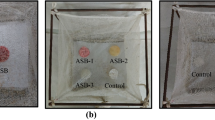Abstract
Attractive toxic sugar bait (active ingredient, 1 % boric acid) was evaluated against Aedes albopictus Skuse populations in the laboratory, semi-field trials, and field trials in residential communities in St. Augustine, Florida. Laboratory evaluations of boric acid sugar baits applied to the plant Pentas lanceolata (Rubiaceae) demonstrated 100 and 92 % mortality of A. albopictus at day 7 and 14, respectively. A semi-field study evaluating the bait application to the upperside or topside of leaves resulted in no significant difference on mortality (P > 0.05). Overall combined top and bottom boric acid sugar bait application mortality at day 7 was 95 % based on leaf bioassays. Field application of the boric acid sugar baits significantly (P < 0.05) decreased adult A. albopictus populations up to day 21 post-treatment compared to the pre-treatment population numbers. A significant reduction in oviposition was demonstrated both at day 7 and 14 post-application (P = 0.001) as monitored by ovitraps. Attractive toxic sugar bait application in tropical environments demonstrated efficacy, persistence, and feasibility in controlling A. albopictus populations.
Similar content being viewed by others
References
Allan SA (2011) Susceptibility of adult mosquitoes to insecticides in aqueous sucrose baits. J Vector Ecol 36:59–67
Allan SA, Kline DL, Walker T (2009) Environmental factors affecting efficacy of bifenthrin-treated vegetation for mosquito control. J Am Mosq Control Assoc 25:338–346
Beier JC, Müller GC, Gu W, Arheart KL, Schlein Y (2012) Attractive toxic sugar bait (ATSB) methods decimate populations of Anopheles malaria vectors in arid environments regardless of the local availability of favored sugar-source blossoms. Malar J 11:31
Benedict MQ, Levine RS, Hawley WA, Lounibos LP (2007) Spread of the tiger: global risk of invasion by the mosquito Aedes albopictus. Vec Borne and Zoo Dis 7:76–85
Clements AN (1992) The biology of mosquitoes, 1st edn. Chapman & Hall, London
Foster WA (1995) Mosquito sugar feeding and reproductive energetics. Ann Rev Entomol 40:443–474
Gratz NG (2004) Critical review of the vector status of Aedes albopictus. Med Vet Entomol 18:215–227
SAS Institute (2001) SAS version 8.1. North Carolina: Cary.
Müller GC, Schlein Y (2008) Efficacy of toxic sugar baits against adult cistern-dwelling Anopheles claviger. Trans R Soc Trop Med 102:480–484
Müller GC, Schlein Y (2011) Different methods of using attractive sugar baits (ATSB) for the control of Phlebotomus papatasi. J Vector Ecol 36(Suppl 1):S64–S70
Müller GC, Kravchenko VD, Schlein Y (2008) Decline of Anopheles sergentii and Aedes caspius populations following presentation of attractive toxic (spinosad) sugar bait stations in an oasis. J Am Mosq Control Assoc 24:147–149
Müller GC, Beier JC, Traore SF, Toure MB, Traore MM, Bah S, Doumbia S, Schlein Y (2010a) Successful field trial of attractive toxic sugar bait (ATSB) plant-spraying methods against malaria vectors in the Anopheles gambiae complex in Mali. West Africa Malar J 9:210
Müller GC, Junnila A, Schlein Y (2010b) Effective control of adult Culex pipiens by spraying an attractive toxic sugar bait solution in the vegetation near larval habitats. J Med Entomol 47:63–66
Radke EG, Gregory CJ, Kintziger KW, Sauber-Schatz EK, Hunsperger EA, Gallagher GR (2012) Dengue outbreak in Key West, Florida, USA, 2009. Emerg Infect Dis. doi:10.3201/eid1801.110130
Reiter P (1998) Aedes albopictus and the world trade in used tires, 1988–1995: the shape of things to come? J Am Mosq Control Assoc 14:83–94
Schlein Y, Müller GC (2010) Experimental control of Phlebotomus papatasi by spraying attractive toxic sugar bait (ATSB) on vegetation. Trans R Soc Trop Med Hyg 104:766–771
Xue RD, Kline DL, Ali A, Barnard DR (2006) Application of boric acid baits to plant foliage for adult mosquito control. J Am Mosq Control Assoc 22:497–500
Xue RD, Ali A, Kline DL, Barnard DR (2008) Field evaluation of boric acid and fipronil-based bait stations against adult mosquitoes. J Am Mosq Control Assoc 24:415–418
Xue RD, Müller GC, Kline DL, Barnard DR (2011) Effects of application rate and persistance of boric acid sugar baits applied to plants for control of Aedes albopictus. J Am Mosq Control Assoc 27:56–60
Yuval B (1992) The other habit: sugar feeding by mosquitoes. Bull Soc Vector Ecol 17:150–156
Acknowledgments
The authors want to thank the staff of AMCD including James Wynn, Pat Kendrick, and Richard Weaver, and colleagues at University of Miami, Nora Cobo, Marc Gellman, and Maria Pattany.
Author information
Authors and Affiliations
Corresponding author
Rights and permissions
About this article
Cite this article
Naranjo, D.P., Qualls, W.A., Müller, G.C. et al. Evaluation of boric acid sugar baits against Aedes albopictus (Diptera: Culicidae) in tropical environments. Parasitol Res 112, 1583–1587 (2013). https://doi.org/10.1007/s00436-013-3312-8
Received:
Accepted:
Published:
Issue Date:
DOI: https://doi.org/10.1007/s00436-013-3312-8




